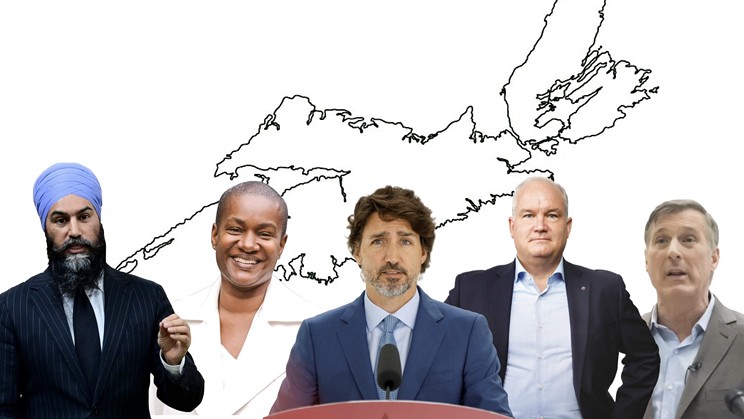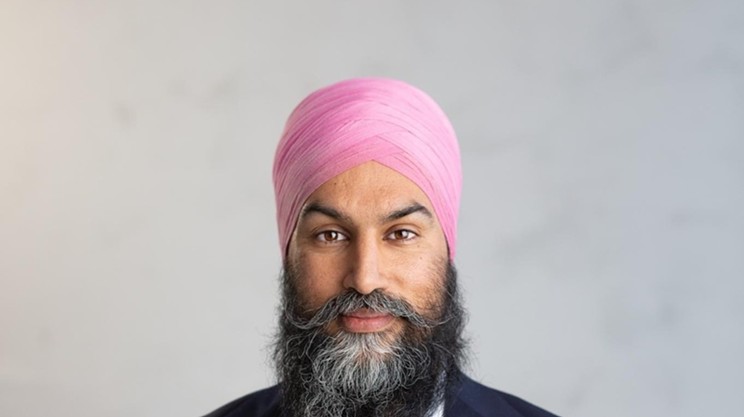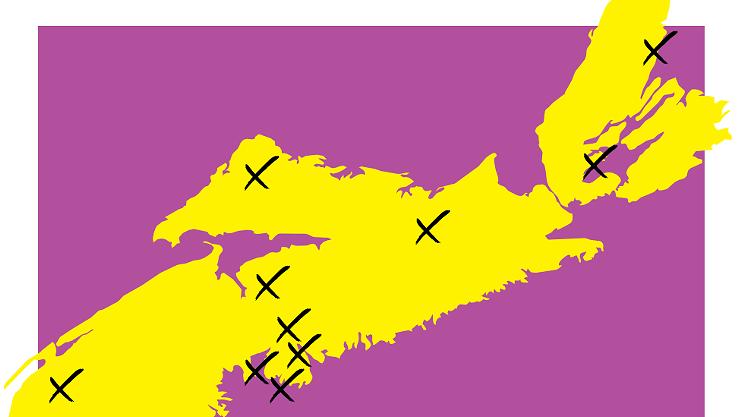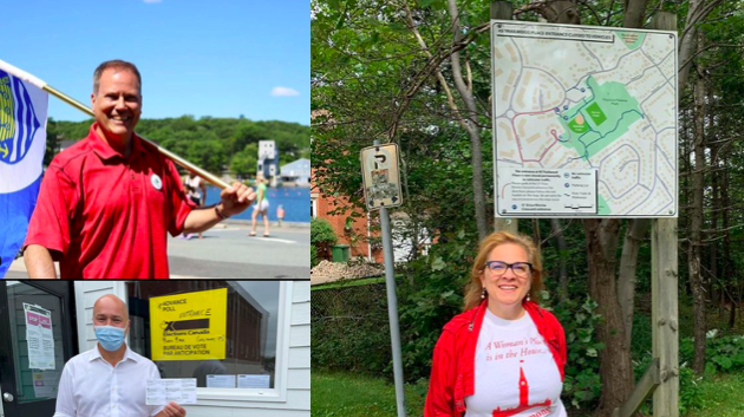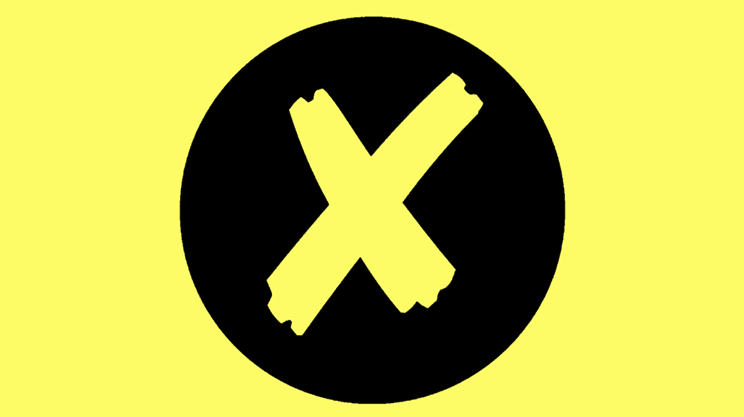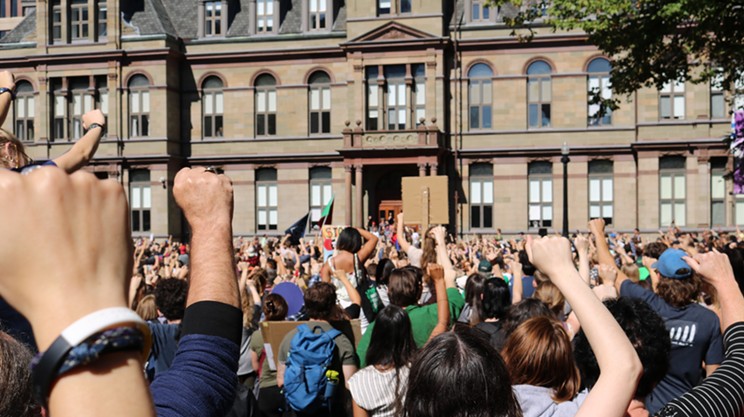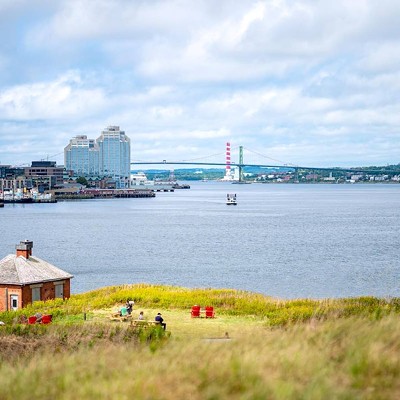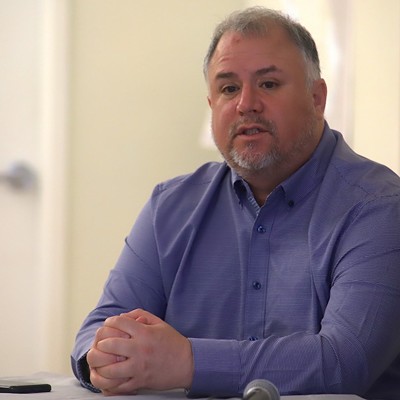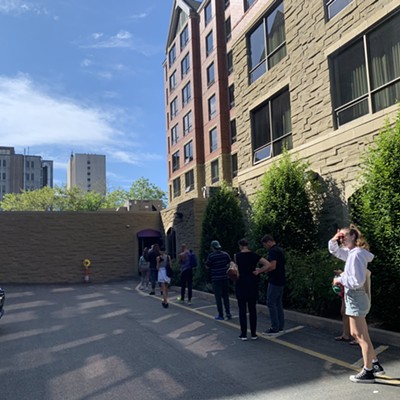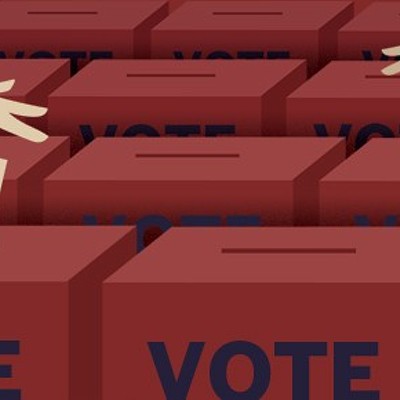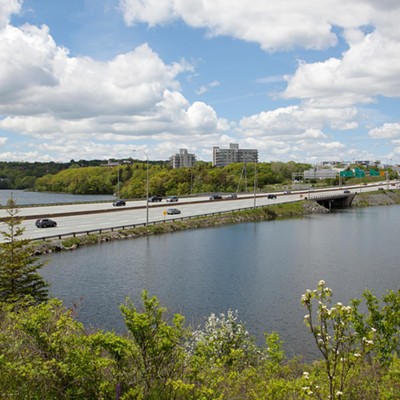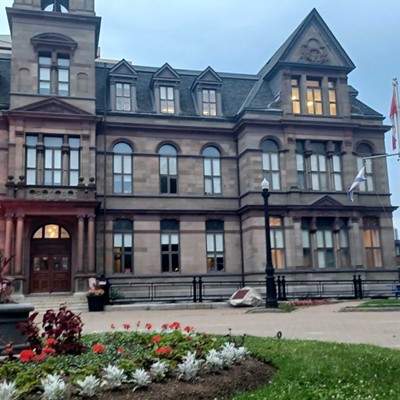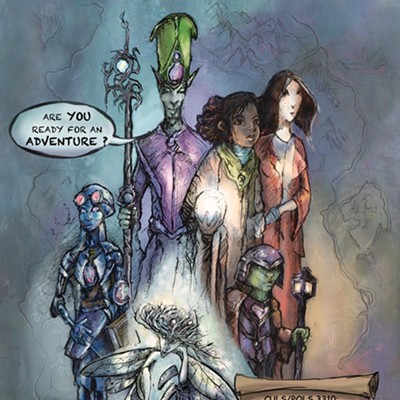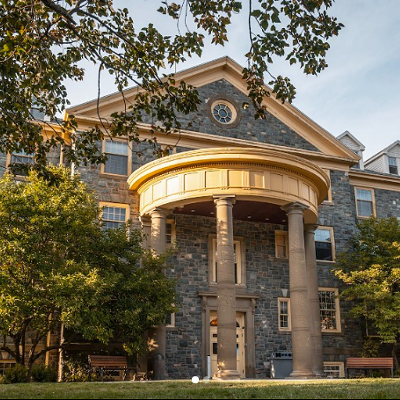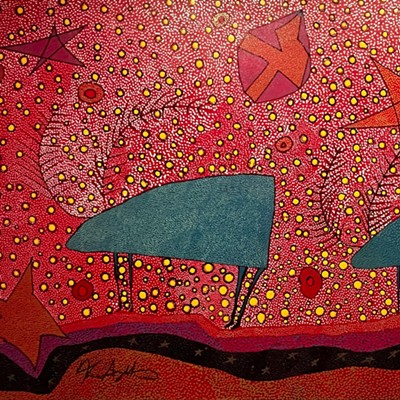Earlier this month, we wrote about who is running in each of the Nova Scotia ridings in the federal election. As the candidates battle it out on a local level, national party leaders are also drawing a smidge of their attention towards Nova Scotia, which flipped from Liberal to Progressive Conservative in the provincial election just last month.
To help you get ready for voting day this Monday, September 20, here’s what each party is saying about eight of the biggest issues Nova Scotians are talking about. Read from top to bottom, or click a topic link to jump to that section of the story: the environment, jobs, health care, treaty rights, immigration, housing, the pandemic and rural voters. The parties are listed in alphabetical order in each topic.
Environment
The Conservative Party’s environmental campaign has stuck mostly to fisheries: leader Erin O’Toole’s platform says “salmon farming on Canada’s West Coast has been controversial” and “local communities are confused and torn by conflicting studies and claims.” O’Toole says the decisions made on the Pacific “could have ripple effects on the East Coast as well.” The Tories also promise to eliminate the “unfairness” of prime minister Justin Trudeau’s Bill C-69 environmental protection bill, and “implement a Critical Minerals Strategy to take advantage of Canada’s abundant resources.”
Coming from the party that’s historically had a particular dedication to environmental issues, the Green Party platform pledge to increase carbon taxes by $25 per tonne every year from 2022 to 2030 isn’t a surprise. The Greens also promise to expand the list of non-essential, single-use plastics that will be banned before the end of the year, and say they would establish a new office of environmental justice at Environment and Climate Change Canada.
The Liberal Party platform says a re-elected government would establish 10 new national parks and 10 new national marine conservation areas in the next five years, doubling the amount of protected Crown land across Canada. The Liberals also promise to invest $50 million in community shoreline and plastic cleanup from the ocean, and to expand the Ghost Gear Program—collecting lost fishing gear, which is an issue impacting right whales in Atlantic Canadian waters.
The only time the NDP platform specifically mentions “the Atlantic coast” is its promise to “ensure that resource allocations in the fishery are guided by the principles of adjacency, historic dependence and sustainability, while also respecting Indigenous rights.” The New Democratic Party also promises to aim for a more ambitious greenhouse gas reduction target of 50 percent below 2005 levels by 2030, creation of an environmental bill of rights and to protect 30 percent of land, freshwater and oceans by 2030.
And finally, the People’s Party of Canada platform falsely claims that “climate change alarmism is based on flawed models that have consistently failed at correctly predicting the future.” The party says there has been “no steady warming in direct relation with increases in CO2 levels,” and says it would withdraw Canada from the United Nations Paris Accords on climate change.
jump back to the topic list or just keep reading
Jobs
The Conservative platform again reinforces its support for fisheries, promising to double funding for commercial wharves in the Small Craft Harbours Program, which it says are “especially central to communities in Newfoundland and Labrador, Nova Scotia, Prince Edward Island, and New Brunswick.” The Conservative platform also includes a specific section called Rebuilding Main Street, which “will provide a 25 percent tax credit on amounts of up to $100,000 that Canadians personally invest in a small business over the next two years.“
The Green Party platform includes a lot about green jobs. It plans to enact legislation on green jobs training programs, including jobs related to ecosystem restoration, “particularly for people who have been displaced or severely affected by COVID-19.” Leader Annamie Paul plans to keep the small business tax rate below nine percent, and says she will extend wage and commercial rent subsidies until all pandemic restrictions are fully lifted. The Greens say they will put $1 million in a Green Venture Capital Fund for small, local green business start-ups, and invest in the cleantech sector and in renewable energy, “which will create more, and higher paying jobs than those lost in the fossil fuel sector.”
For the Liberal Party, the focus on jobs is under the Canada Workers Benefit, which a Liberal government will expand to cover one million Canadians in low-paying jobs, as well as on reformatting the EI system to apply better to self-employed people. Trudeau’s platform also boasts the $10-a-day child care program for job creation, as well as some posthumous bragging about the Canada Emergency Wage Subsidy.
The NDP says it’s “committed to making work better with supports like paid sick leave and prescription drug coverage,” promising to put $10 billion a year into the latter. The party promises to create a new low-income supplement, so that those on EI regular or special benefits get at least $2,000 each month. The NDP also says it “should be easier to join a union that will protect your rights and ensure fair working conditions,” and leader Jagmeet Singh has said he will implement a living federal minimum wage starting at $15 an hour and rising to $20 an hour.
The People’s Party promises to eliminate all corporate subsidies and government interventions—from bailouts to regional development grants, conditional loans and loan guarantees to tax credits—to save between $5 and $10 billion a year. PPC leader Maxime Bernier also says he will reduce the corporate income tax rate from 15 percent down to 10 percent, and abolish the personal capital gains tax, which currently sits at 50 percent.
jump back to the topic list or just keep reading
Health care
The Conservative platform largely focuses on mental health. The party would “create a nation-wide, three-digit suicide prevention hotline,” similar to the one the PCs promised in Nova Scotia during the provincial election. The Tories also promise to “boost funding to the provinces for Mental Health care” but don’t give specifics. The party will offer employers a tax credit for 25 percent of the cost of employee mental health coverage for the first three years, and create a pilot program for $150 million in grants to non-profits and charities over three years. In terms of doctor shortages, they plan to grow the Canada Health Transfer to the provinces to six percent, adding $60 billion across the country, and the party plans to attract more immigrants to come work in health care in Canada by working with the provinces.
The Green Party’s priorities in health care are focused on increasing Indigenous-led mental health and youth mental health resources. The party promises to establish both a national mental health strategy and a suicide prevention strategy, and to expand the single-payer Medicare model of the Canada Health Act to include Pharmacare for everyone. The Green platform also says the party would approach the drug poisoning (opioid) crisis as a health care issue, not a criminal issue.
The Liberals say they will provide $3.2 billion to the provinces and territories for the hiring of 7,500 new family doctors, nurses and nurse practitioners. The health care platform also promises $400 million over four years invested into virtual care, the creation of a safe long-term care act to protect seniors, and says within the first 100 days of being re-elected, a Liberal government would implement 10 days of paid sick leave for all federally regulated workers.
The NDP platform promises the federal government will step up to close the health gap in Indigenous communities. Party leader Singh also says he will work with the provinces to reduce health care wait times: “We will identify coming gaps in health human resources and make a plan to recruit and retain the doctors, nurses and other health professionals Canadians need.” Similar to the Liberals, the NDP promises the creation of national care standards for long-term care homes, but go further by saying they would end private, for-profit long-term care and bring long-term care homes under the public umbrella.
The PPC platform on health care advocates for a two-tiered system of public-private health care, and says those systems “guarantee citizens equal access.” The party plans to change the way Canada Health Transfers go to the provinces and instead give GST to provinces to spend on health care. Then the PPC says it would give all health care power to the provinces—“they will be fully responsible for health care funding and management, and fully accountable to their citizens for the results, while Ottawa will respect the Constitution and stop meddling.”
jump back to the topic list or just keep reading
Treaty rights
Back in October 2020, the Liberal and Conservative parties faced off about the Nova Scotia lobster dispute in the House of Commons. With Erin O’Toole saying “all fishers in Nova Scotia, Indigenous and non-Indigenous want a moderate livelihood and wellbeing for their family.” The PM responded by saying “over the past 21 years since the Marshall decision, governments of all stripes including the Conservative government have made progress on the question of resolving moderate livelihood” and said “we will continue to work with Indigenous peoples.”
But despite that exchange, neither the Liberals nor Conservatives have a specific position in their platforms about treaty rights in Atlantic Canada. The Tories mention treaties mainly related to “responsible development” and “resources,” saying “recent events have illustrated the scale of the obstacles that Indigenous peoples have faced throughout Canada’s history, and Canadians are more determined to move forward with reconciliation than ever before.” On the other hand, the Liberals say they will work with “residential school survivors, Indigenous Peoples, provinces, territories, and educators to incorporate aboriginal and treaty rights, the history of residential schools and Indigenous contributions into the school curricula.”
The Green Party platform says “in Atlantic Canada, the 2020 Mi’kmaq lobster situation revealed racism and a weak commitment to Indigenous treaty rights through unclear interpretations of laws.” Leader Annamie Paul says the party will transition out from under the outdated Indian Act and work towards the creation of an Indigenous lands and treaties tribunal act which will “establish an independent body that will decide on specific claims, ensuring that treaty negotiations are conducted and financed fairly and that treaty negotiations and claims resolutions do not result in the extinguishment of aboriginal and treaty rights.” The Greens also plan to support Indigenous-led protected and conservation areas and fund stewardship of these lands and waters by Indigenous guardians.
Looking at the federal NDP, Jagmeet Singh directly responded to a question from a Mi’kmaw grandmother when he visited Halifax in August. “He basically pushed that off to Trudeau,” she said. “Yet if he were to come into power that would be one of his issues to look at.” Despite that, the NDP platform promises the party would establish a comprehensive plan to address violence against Indigenous women, girls and 2SLGBTQ+ people, and support Indigenous-led nature conservation, land use and climate planning. Singh has also said the NDP would fully implement the Truth & Reconciliation Report’s 94 Calls to Action and establish a National Council for Reconciliation.
The PPC says Indigenous issues are varied and complex, but that “it is not possible to address more than a few of these issues in the context of this election platform.” Bernier also promises to reform the Indian Act, as well as “explore further avenues to promote the establishment of individual property rights on reserves so as to empower its residents, and give them increased control over their lives.” The platform also promises to “review federal spending to ensure that programs are better targeted to benefit the indigenous population, in particular the communities that have the greatest needs.” (The party does not capitalize the word Indigenous.)
jump back to the topic list or just keep reading
Immigration
The Conservative plan for immigration is to allow the “best and brightest from around the world to fill critical gaps and robustly grow our economy.” The party claims it will reunite families separated by borders and clear the administrative backlog by “creating an efficiency mechanism, where those waiting for their application to be reviewed can pay a fee for expedited processing.” The Tories will also eliminate the Liberals’ “family reunification lottery” and replace it with a first-come, first-served program where those with language proficiency can be prioritized.
The Greens say they will address all forms of hate and xenophobia in the immigration process; revise practices like immigration detention centres and family separation; and develop an oversight mechanism including a Civilian Complaint and Review Commission. The party promises to update the citizenship guidebook to include a more accurate history of Canada and Turtle Island, including the racism and colonial history, and end the safe third country agreement with the United States. To help fill health care shortages, the Greens also say they will also prioritize senior care and long-term care skills for immigration status.
The Liberals’ plan for immigration is to get wait times for family reunification applications under 12 months. On top of that, it will expand the express entry points system for permanent residence for temporary foreign workers and former international students, and create a trusted employer system to streamline the application process for companies hiring TFWs to fill labour shortages Canadians can’t fill.
The NDP plan for reducing red tape around immigration starts with ending “the unfair cap on applications to sponsor parents and grandparents, and take on the backlogs that are keeping families apart.” The party also promises to better regulate the immigration industry and treat newcomers with dignity and respect, calling out hate like “anti-Black racism, anti-Semitism, Islamophobia, gender-based violence, homophobia, and transphobia.” Singh has also promised he will ban “street checks” by the RCMP and to “work with local partners across Canada to end this practice in all jurisdictions across the country.”
The PPC immigration platform says that the “primary aim of Canada’s immigration policy should be to economically benefit Canadians and Canada as a whole. It should not be used to forcibly change the cultural character and social fabric of our country.” Additionally, Bernier has said he will reduce the number of immigrants and refugees Canada accepts annually from 350,000 down to under 150,000. The PPCs want to “limit the number of immigrants accepted under the family reunification program, including abolishing the program for parents and grand-parents.”
jump back to the topic list or just keep reading
Housing
Another topic where the provincial Progressive Conservatives align with the federal Tories is the suggestion that the housing crisis is because “supply simply isn’t keeping up with demand.” Erin O’Toole’s platform says the party would release 15 percent of 37,000 federal-owned properties for housing, and that the Conservatives would “ban foreign investors not living in or moving to Canada from buying homes here for a two year period.” The party says homelessness would be reduced by the creation of 1,000 residential drug treatment beds, and if elected it will build 50 recovery community centres across the country.
For the Green Party, housing priorities include appointing a federal housing advocate, as established in the National Housing Strategy Act, and declaring housing affordability and homelessness a national emergency. The party promises to redefine affordable housing using a new formula “that accounts for regional variations across the country” and to establish a national moratorium on evictions at least until the pandemic is over. Leader Annamie Paul also promises to create national standards on rent, and build 50,000 supportive housing units and 300,000 units of deeply affordable non-market, co-op and non-profit housing over 10 years.
The Liberals say they will introduce a new rent-to-own program to help make it easier for renters to get on the path towards home ownership while renting, but the landlord must agree to rent at a lower-than-market rate for this to work. Liberal leader Justin Trudeau’s platform says the party would create a new TFSA-type account where Canadians can save and withdraw $40,000 tax-free for a downpayment, with no commitment to repay. The party also promises to “build or revitalize” 250,000 homes over the next four years to add to housing stock.
A New Democrat government will create at least 500,000 units of quality, affordable housing in the next 10 years, with half of that done within five years. The party promises if it comes into power, there will be “safe and affordable housing in every Indigenous community, on and off reserve.” On top of this, the NDP say they will waive the federal portion of the GST/HST on the construction of new affordable rental units, and to address homelessness will work with the provinces and municipalities to “fast-track the purchase, lease and conversion of hotels and motels for emergency housing relief until more permanent, community-based solutions are available.”
The PPC platform says the current housing market is the “mismatch between supply of and demand for housing.” The platform mostly addresses the issue in Toronto and Vancouver, leaving Halifax out and blaming immigrants. The People’s Party will completely stop funding social housing, “which unfairly competes with private developers and has historically been a financial, social and urban planning disaster in every city where it’s become widespread. It is not the government’s role to build and rent apartments. Dependency on government handouts is never the solution.“
jump back to the topic list or just keep reading
The pandemic
The Conservative Party says if elected, it will reinstate the tariff on imported personal protective equipment, trying to get more Canadian-made PPE on Canadians’ faces. The Tories also promise in their platform to wind down emergency COVID support programs “in a responsible way as Canadians are vaccinated and the economy re-opens.” The party says it will “prioritize the signing of contracts for booster shots to ensure that Canadians are protected as quickly as possible against new variants,” and will “deploy rapid testing at all border entry points and airports to screen new arrivals.”
The Green Party says if elected, it will prepare for future pandemics by investing in and restructuring our health care and long-term care systems. This includes making sure the country’s PPE stockpile is sufficient, lessening Canada’s overall dependence on global supply chains for essential goods and services, and ensuring we have capacity to manufacture pharmaceuticals and our own vaccines. The party promises to order a public inquiry that evaluates the joint COVID response between all levels of government, and to create an intergovernmental rapid response task force for the next “emergency.”
The Liberal platform says women, racialized and immigrant workers are at greater risk of infection, and puts a push on continuing to get people vaccinated: “creating healthier indoor environments allows us to keep our frontline workers—mostly women—as safe as possible.” Trudeau has also said the Liberals would implement mandatory vaccines on planes, trains and for federal employees, and get free booster shots for everyone while also creating a $1 billion proof of vaccination fund to help the provinces to figure out their POV and/or vaccination record plans.
The NDP addresses COVID first through the retrofit of all buildings built before 2020: this will save on home energy costs, but also the goal “to improve indoor air quality will also help prevent further waves of COVID-19.” Singh’s platform also says national pharmacare and dental care programs would “free up resources to tackle emerging threats to public health, like the COVID-19 pandemic,” and the New Democrats say they will establish a Crown corporation charged with domestic vaccine production, and work with universities and experts to make sure public research on critical health issues continues.
The PPC platform includes a specific section about COVID policy that says the party opposes mask mandates and “vaccine passports.” The party says it would repeal such mandates as well as mandatory testing for federal employees. The party’s website speculates that governments “don’t want to admit that they were wrong and are imposing increasingly authoritarian measures on the population, including vaccine passports,” and says Bernier would fire Canada’s top public health official Theresa Tam if elected, replacing her with someone who won’t follow World Health Organization recommendations.
jump back to the topic list or just keep reading
Rural voters
The Conservatives specifically promise rural voters their voices will be heard and their concerns addressed. “Whether they live in rural Nova Scotia, or rural Saskatchewan, or a remote community in Northern Ontario, or anywhere else in the country, the interests of our rural populations must never be ignored by urban politicians,” says the party platform. O’Toole also held a rally in Cape Breton in August, where he discussed his platform for “Canada’s Recovery Plan” with a specific focus on the economy and opportunities of the area.
The Green Party recognizes that 20 percent of Canadians live in rural and remote environments. For these people, Annamie Paul promises she will try to tackle youth retention as well as ensuring the aging population has adequate health care via telemedicine. The party promises to implement affordable internet in rural areas of Canada, and to replace imported food with local agriculture—putting $15 billion into the economy.
The Liberal appeal to rural voters has largely focused on health care, with the platform promising to “expand the number of family doctors and primary health teams in rural communities.” This will be accomplished by forgiving more doctors’, nurse practitioners’ and nurses’ Canada student loan debt, up to $60,000 total. The Liberals celebrate their Universal Broadband Fund and increase of rural public transit, and claim they will strengthen the economy by building Canada’s regional development agencies like the Atlantic Canada Opportunities Agency.
The NDP has also addressed rural and Nova Scotian voters specifically, with leader Jagmeet Singh making a trip to the province in August during the provincial election, just before the federal writ was dropped. While there isn’t much about the Maritimes in the NDP platform, Singh spoke to local NDP representatives and constituents about housing, health care and prescription drugs. The party platform itself highlights making rural broadband an “essential service” as well as bridging the education gap for rural and remote students, and bringing back door-to-door mail delivery.
The People’s Party platform doesn’t directly address the rural-urban divide, preferring instead to encourage divisions between what it calls “Canadians” and “immigrants,” and what those with a broader understanding of 10,000+ years of history might call “settlers” and “settlers” of Turtle Island. Bernier’s platform rejects multiculturalism for the goals of keeping our country “unified” and ensuring “social cohesion.”
jump back to the topic list

